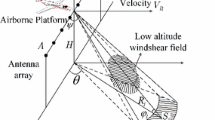Abstract
By detecting the severe meteorological situations on flight route, airborne weather radar (WXR) can ensure the safety of the aircraft and on-board personnel. Among these critical weather conditions, atmospheric turbulence is one of the main factors that affect flight safety. Atmospheric turbulence detection method that the current WXR adopts mainly is the pulse pair processing (PPP) method, which estimates Doppler spectrum width of weather target echo and compares it with a threshold to determine whether this weather target is turbulence or not. PPP method is simple and easy to implement, but the performance of this method under the condition of low signal-to-noise ratio (SNR) is poor. In this paper, we propose a new turbulence detection method based on the principal component analysis (PCA) approach. This new method uses PCA approach to preprocess the weather target echo and divides it into two parts: the principal component part as signal and the rest part as noise, so as to realize the de-noising function of PCA approach, and it is then combined with PPP method to estimate the spectrum width. Due to the good de-noising performance of PCA approach, this new method improves the detection performance of traditional PPP method especially under the condition of low SNR.






Similar content being viewed by others
References
Dias JMB, Leitao JMN (2000) Nonparametric estimation of mean doppler and spectral width. IEEE Trans Geosci Remote Sens 38:271–282
Yanovsky FJ, Russchenberg HWJ, Unal CMH (2005) Retrieval of information about turbulence in rain by using doppler-polarimetric radar. IEEE Trans Microw Theory Tech 53:444–450
Zrnic DS (1979) Estimation of spectral moments for weather echoes. IEEE Trans Geosci Electron 17:113–128
Abeysekera SS (2006) Efficient Frequency estimation using the pulse-pair method at various lags. IEEE Trans Commun 54:1542–1546
Liu XY, Li Y, Cheng YF (2012) Simulation and analysis of turbulence signals in airborne pulse doppler radar. Syst Eng Electron 34:920–924
Yu YJ, Li Y (2015) An airborne weather radar turbulence signal detection method and simulation. J Northw Poly Tech Univ 33:159–164
Sirmans D, Bumgarner B (1975) Numerical comparison of five mean frequency estimators. J Appl Meteorol 14:991–1003
Zrni DS (1975) Simulation of weather like doppler spectra and signals. J Appl Meteorol 14:619–620
Rummler WD (1967) A technique for improving the clutter performance of coherent pulse train signals. IEEE Trans Aerosp Electron Syst AES-3(6):898–906
Groginsky HL, Soltes AS, Works GA, Benham FC (1972) Pulse pair estimation of doppler spectrum parameters. Contract F-19628-71-C-0126. Raytheon Company, Wayland
Rao DUM, Reddy TS, Reddy GR (2014) Atmospheric radar signal processing using principal component analysis. Digit Sign Process 32:79–84
Benchebha Z, Mohand L, Bettayeb M (2016) Pulse doppler spectral moment estimation by PCA approach. In: IEEE, Cistem
Lagha M, Tikhemirine M, Bergheul S et al (2013) De-noised estimation of the weather Doppler spectrum by the wavelet method. Digit Sign Process 23:322–328
Acknowledgments
This paper is sponsored by National Program on Key Basic Research Project (2014CB744903), National Natural Science Foundation of China (61673270), Shanghai Pujiang Program (16PJD028), Shanghai Industrial Strengthening Project (GYQJ-2017-5-08), Shanghai Science and Technology Committee Research Project (17DZ1204304), and Shanghai Engineering Research Center of Civil Aircraft Flight Testing.
Author information
Authors and Affiliations
Corresponding author
Rights and permissions
About this article
Cite this article
Zhang, Q., Xiao, G., Lan, Yq. et al. Atmospheric turbulence detection by PCA approach. AS 2, 15–20 (2019). https://doi.org/10.1007/s42401-018-0012-1
Received:
Revised:
Accepted:
Published:
Issue Date:
DOI: https://doi.org/10.1007/s42401-018-0012-1




